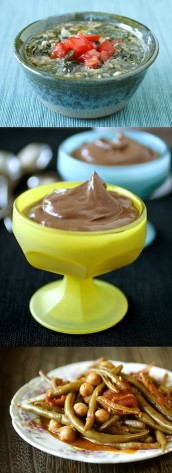Three Magazines, Seven Cooks

Rustic Parsley & Orzo Soup (E.W.), Creamy Chocolate Pudding (C.I.), Lebanese-Style Green Beans (Saveur)
Surprising pleasures of the table revealed by preparation of foolproof recipes, but which are disguised, at first read, by a thematic focus on health and nutrition.
A behind-the-scenes look at recipe development, also known as “The Making of . . . ,” approach, that delves into the whys and hows of how food works.
Vicarious travel, through stories both personal and cultural, to home kitchens, food carts, markets, and restaurants close to home and far flung, and vicarious enjoyment of the foods produced therein, with accompanying recipes as an added benefit.
These descriptions are how I think of the three magazines that DCCC just finished reading, cooking from, and comparing: Eating Well, Cook’s Illustrated, and Saveur. Each is so different, revealing the very different ways in which food can be approached and experienced. Whereas the staff at a magazine decides a theme in order to carve out a niche in the market, most of us probably approach food in all of these ways, and more, simultaneously.
Doing a magazine comparison, particularly of magazines as different as these, stimulates a great deal of self-food-assessment, if you’re prone to that sort of thing. Do you find yourself becoming annoyed, bored, intrigued, or entertained by content? These states are effective mirrors of your likes and dislikes, reminders of what excites you about food, and are possibly a reflection of your assumptions about an approach to food, or that of a publication.
Eating Well, for example, isn’t a magazine I would normally be drawn toward. Even though I like to eat healthy and nutritious food, it, as a subject, isn’t what excites me about food, gets me into the kitchen, or animates my conversations about food with other food lovers. Yet, 99 percent of the recipes I and the other DCCC members tried from Eating Well were very pleasurable, very flavorful, and subtly seasoned and spiced. This realization made me ponder the openness of the publication’s title: “Eating well” can mean different things to different people, and has meant different things in different ages. Perhaps I should have paid more attention to the magazine’s tagline before making assumptions: “Where Good Taste Meets Good Health.”
Some members qualified their experience as one of magazine versus cookbook. One member said she felt there is something special about receiving a magazine in the mail—a surprise each month (or every other month) geared to seasonal produce or holiday foods that is timed perfectly to just what you’re thinking about making. In a cookbook, she commented, you need to search for recipes for seasonal foods. Whereas most members enjoyed cooking from the magazines—some had long had subscriptions to one or more of the magazines, and made recipes from back issues for the potluck—one member decidedly said she prefers cookbooks. She found the ads distracting and the lack of an index (or of a thorough index) an impediment for making easy use of the recipes, and she didn’t like the “surprise” factor of not knowing what the content will be and not knowing if there will be any recipes that will appeal.
At the DCCC potluck, the discussion tended to wind it way around the success of the recipes themselves, with those from Eating Well being in more numerous representation. No single magazine won out. Most everyone liked all three, and liked each for particular reasons: Melanie, for example, appreciates the technical “how and why” recipe discussions in Cook’s Illustrated as she feels it helps to make her a better cook, and provides a good foundation to which she can add her own creative twists.
With seven DCCC members preparing foods from the three magazines for the potluck, it seemed possible that the meal could be composed of too many unrelated foods, unlike when, for the previous potlucks, we’ve prepared food from a cookbook, often one focused on a single ethnic cuisine. But it did come together, one course at a time, beginning with an excellent Manhattan:
1. Manhattan cocktail from Saveur, prepared by me (Except, instead of using the ubiquitous, artificially colored maraschino shown in the photo on Saveur’s site, try the Luxardo brand imported from Italy. They are pricey, but worth it: There is no comparison to the bright red, top-a-hot-fudge-sundae type.)
2. Cheese, Apple and Smoked Turkey Quesadilla, from a Cabot ad in Eating Well, prepared by Miriam
3. Three white bean soups from each magazine, prepared by Jenn, to allow for a direct comparison: Collard Green & Black-Eyed Pea Soup from Eating Well, Italian Pasta and Bean Soup from Cook’s Illustrated, and Tuscan Bean Soup from Saveur
4. Warm Potato Salad with Bacon-Mustard Dressing and Pear-Quinoa Salad from Eating Well, prepared by Melanie
5. Simple Lasagna with Hearty Tomato-Meat Sauce from Cook’s Illustrated prepared by Sam, and Slow-Cooked Broccoli Rabe from Saveur prepared by Wendy
6. Mini Mushroom-&-Sausage Quiches from Eating Well prepared by Tamara, our newest member
7. Creamy Chocolate Pudding from Cook’s Illustrated, prepared by me
Our favorites were the Manhattan cocktail from Saveur, the bean soup from Eating Well, the warm potato salad served with the quinoa salad, both from Eating Well, the lasagna from Cook’s Illustrated, and the chocolate pudding from Cook’s Illustrated.
My favorite surprise takeaway from the club’s magazine comparison was Miriam’s decision to make a recipe in an advertisement, which opens up possibilities of an entirely different sort of comparison, and pondering of how food companies decide what recipe will go in what magazine. In Eating Well, Cabot included a recipe for a smoked turkey quesadilla, which Miriam made, but in Saveur, they opted for a squash & cheddar gratin.
